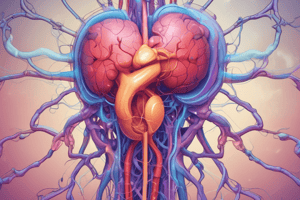Podcast
Questions and Answers
What is important about the elastic recoil in the arterioles?
What is important about the elastic recoil in the arterioles?
During systole, the volume and pressure are transported onto arteries, thus expanding them. During diastole, there is recoil which maintains the pressure and continues to move blood downstream.
Why is low blood pressure bad?
Why is low blood pressure bad?
It causes inadequate blood flow through various organs, leading to malnutrition and inability to remove waste products.
What is the fast response to a change in blood pressure?
What is the fast response to a change in blood pressure?
For an increase in BP, parasympathetic response is stimulated and sympathetic response inhibited, leading to vasodilation and decreased cardiac output.
What is the slow response to a change in blood pressure?
What is the slow response to a change in blood pressure?
Where are baroreceptors located and what do they respond to?
Where are baroreceptors located and what do they respond to?
Describe the baroreceptor reflex mechanism.
Describe the baroreceptor reflex mechanism.
What is orthostatic hypotension?
What is orthostatic hypotension?
What is syncope?
What is syncope?
What happens to baroreceptors during orthostatic hypotension?
What happens to baroreceptors during orthostatic hypotension?
What is an alpha-1 blocker medication?
What is an alpha-1 blocker medication?
What effect does increasing blood volume have on blood pressure?
What effect does increasing blood volume have on blood pressure?
How is the effectiveness of the heart as a pump measured?
How is the effectiveness of the heart as a pump measured?
What regulates the resistance of a system?
What regulates the resistance of a system?
How are changes in blood flow accomplished?
How are changes in blood flow accomplished?
What is a precapillary sphincter?
What is a precapillary sphincter?
What problems do veins face?
What problems do veins face?
What is a venous valve?
What is a venous valve?
Flashcards are hidden until you start studying
Study Notes
Elastic Recoil in Arterioles
- During systole, arteries expand due to increased volume and pressure.
- In diastole, arterial recoil maintains pressure, facilitating blood flow downstream.
Impact of Low Blood Pressure
- Low blood pressure disrupts blood flow from arteries to capillaries, compromising organ function.
- Insufficient blood circulation can result in malnutrition and hinder waste removal.
Fast Response to Blood Pressure Changes
- In response to increased blood pressure, parasympathetic activity is stimulated while sympathetic activity is inhibited.
- This leads to vasodilation and decreased cardiac output, functioning as a negative feedback mechanism to lower blood pressure.
Slow Response to Blood Pressure Changes
- Increased blood volume or pressure triggers kidney responses, increasing urine output.
- The secretion of ADH is inhibited, reducing the reabsorption of water and lowering blood pressure.
Baroreceptors and Chemoreceptors
- Baroreceptors are located in the aorta and carotid sinus; they respond to blood pressure fluctuations.
- Chemoreceptors, adjacent to baroreceptors, monitor changes in pH and CO2 levels.
Mechanism of Baroreceptor Reflex
- Baroreceptors detect blood pressure changes and transmit signals to the medulla's cardiovascular center.
- A rise in blood pressure activates parasympathetic responses, while a decrease triggers sympathetic responses to stabilize heart rate and contraction force.
Orthostatic Hypotension
- Orthostatic hypotension occurs when standing up quickly causes blood to shift away from the brain due to gravity.
Syncope
- Fainting, or syncope, can result from sudden changes in posture, such as standing too quickly.
Baroreceptor Reflex and Orthostatic Hypotension
- Transitioning to a standing position decreases mean arterial pressure, reducing baroreceptor firing.
- This activates sympathetic responses, causing vasoconstriction, increased cardiac contractility, and a rise in blood pressure.
Alpha-1 Blocker Medication
- Alpha-1 blockers for hypertension can exacerbate orthostatic hypotension by impairing arterial constriction during sympathetic stimulation.
Blood Volume and Blood Pressure Effects
- Increasing blood volume generally leads to lower blood pressure; conversely, decreasing blood volume raises blood pressure.
Measuring Heart Pump Effectiveness
- The heart's pumping efficiency is assessed through its rate and stroke volume.
Regulation of Systemic Resistance
- Vessel diameter is the primary factor regulating systemic resistance in the circulation.
Blood Flow Regulation
- Blood flow adjustments occur through changes in resistance in arteries and arterioles via vasoconstriction or vasodilation.
Precapillary Sphincters
- Precapillary sphincters are muscular rings that control blood flow into capillaries.
Challenges Faced by Veins
- Veins operate under low mean pressure, requiring mechanisms to ensure efficient blood return to the heart, especially against gravity in lower extremities.
Venous Valves
- Infoldings in vein endothelium prevent backflow, maintaining unidirectional blood flow toward the heart and ensuring effective circulation.
Studying That Suits You
Use AI to generate personalized quizzes and flashcards to suit your learning preferences.



